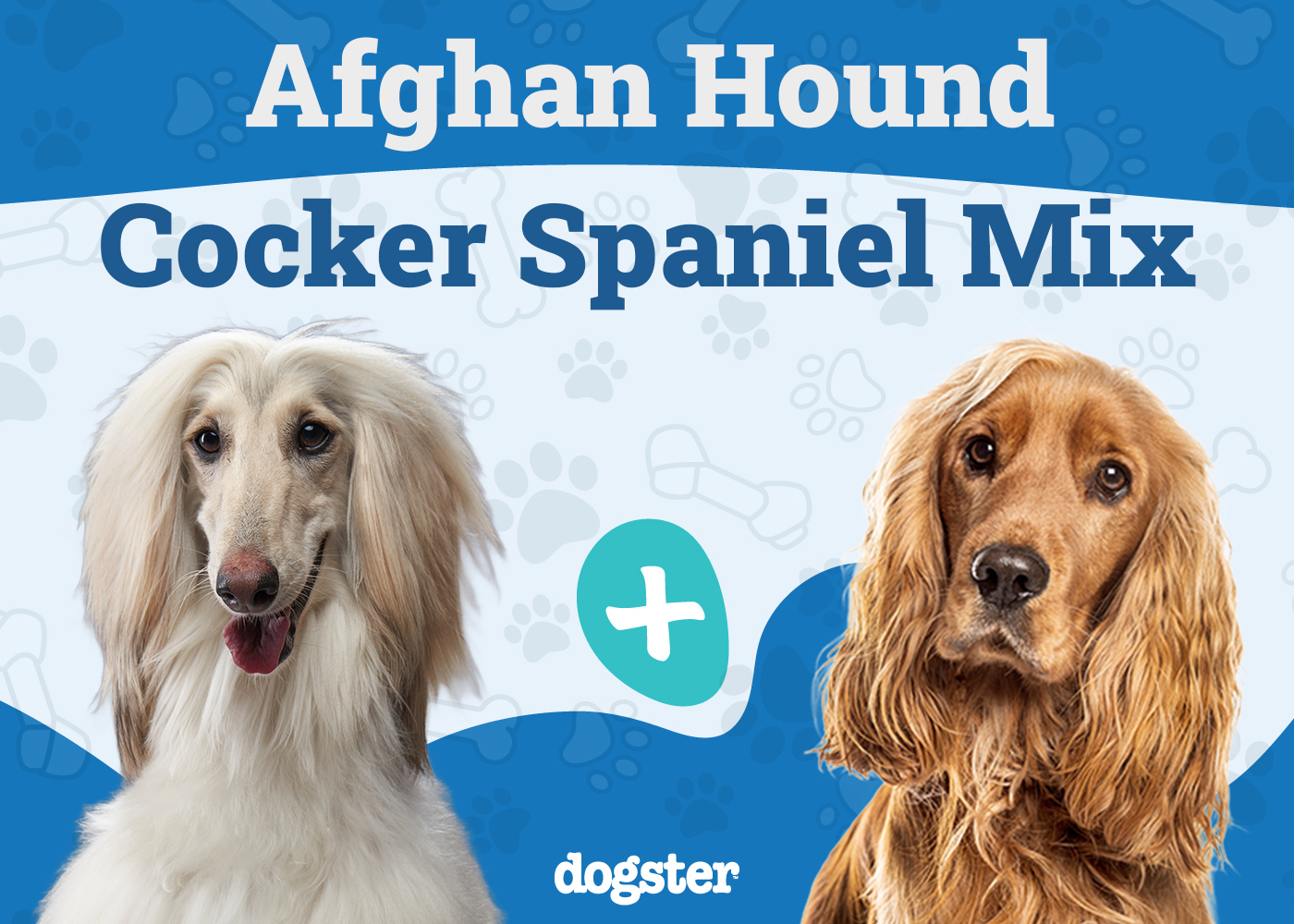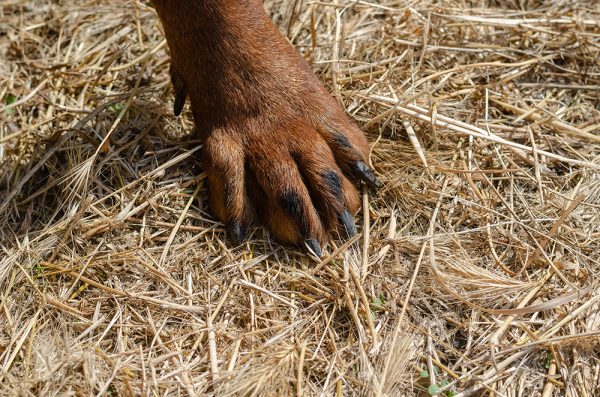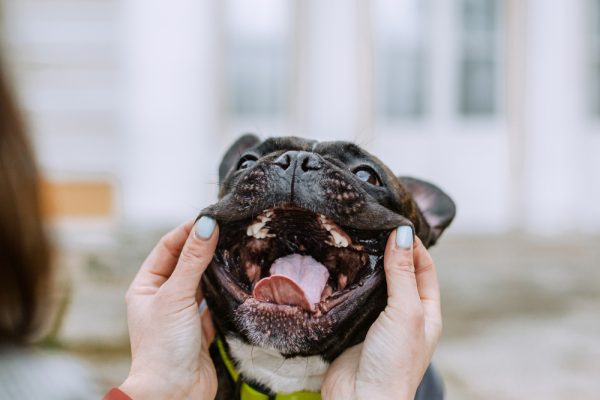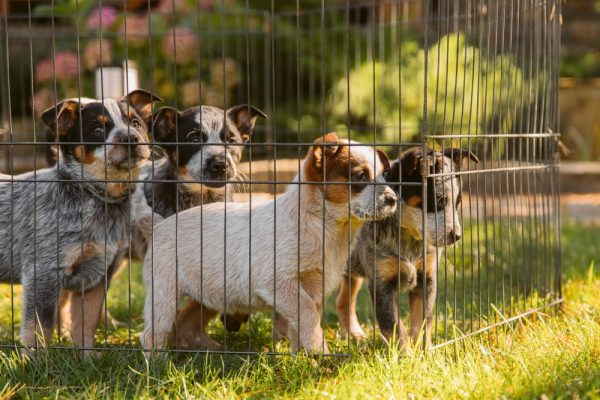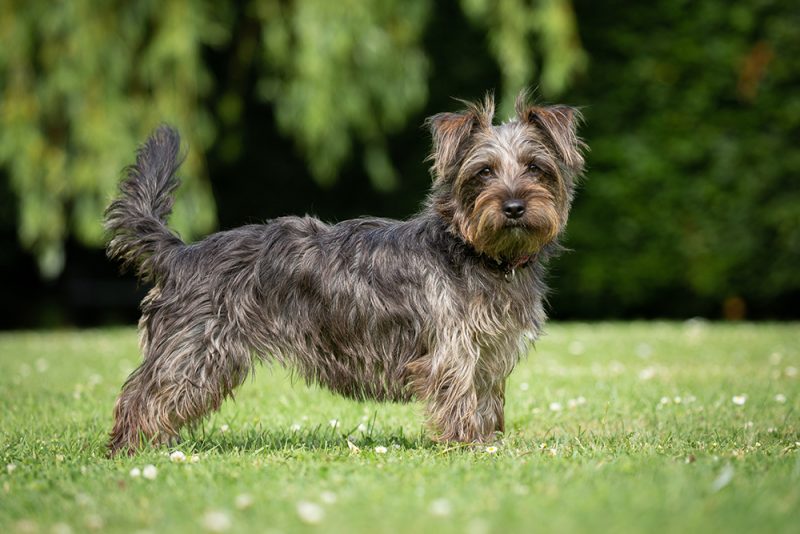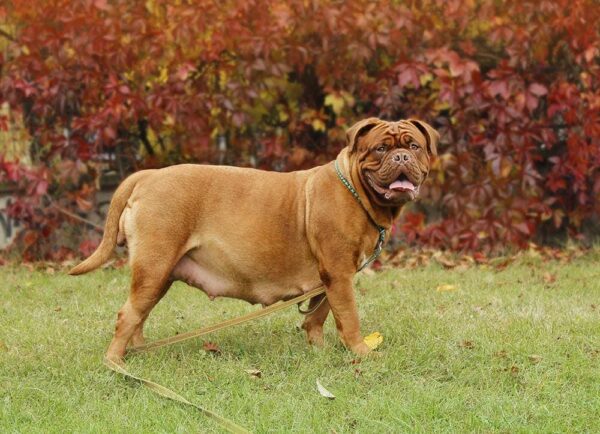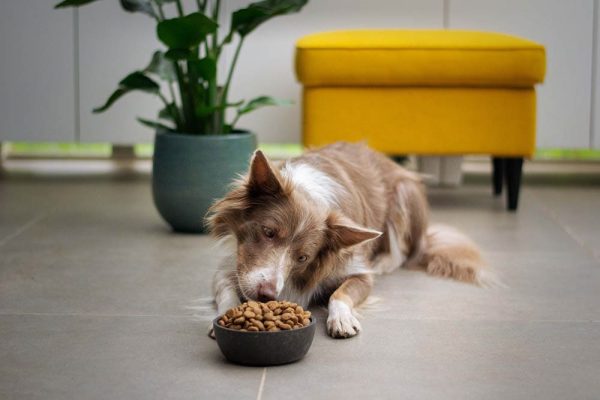In this article
View 8 More +A Hound-Spaniel mix may not make the all-around hunter extraordinaire their pairing might suggest, but you can’t take anything away from this offbeat mixed breed. As loving as they are adorable, the Afghan Spaniel marries many traits that make us cherish their purebred parents.
If you’re currently mulling over an opportunity to take in one of these attractive crosses, we’ll explain what’s in store as we explore the Afghan Spaniel’s temperament, care, and fun facts.
Breed Overview
Height:
19–24 inches
Weight:
30–45 pounds
Lifespan:
12–15 years
Colors:
Black, gray, silver, brown, red, cream, fawn, white
Suitable for:
Active families with older children, first-time owners
Temperament:
Loyal, affectionate, gentle, sensitive, friendly, energetic
The Afghan Spaniel is a sweet and sensitive companion combining two contrasting characters. The Cocker Spaniel is an adaptable, outgoing, and eager-to-please breed, supplying a manageable personality to temper the Afghan Hound’s aloofness and independence.
While it can be tricky to predict which traits will shine through, these mixes will have their parents’ shared easy-going, loving, and loyal personalities, making ownership a daily pleasure.
Afghan Spaniel Characteristics

Afghan Spaniel Puppies
Afghan Spaniels aren’t a common designer dog, so the only places you’ll typically find them are rescues and shelters. If you haven’t located an Afghan Spaniel yet but are interested in the breed, look into breed-specific rescues for Afghan Hounds or Cocker Spaniels, as these often host mixes.
Regardless of where you find your dog, spend as much time as possible with your potential pet before adopting. Afghan Hounds and Cockers have distinct and dissimilar personalities, so it’s crucial to determine where they derive their temperament from and if they’re a good fit for your home.
Once you find and decide on an Afghan Spaniel, you must create a reliable routine and supervise your dog closely. Boundaries will be crucial, especially if you hope to subdue any of the Afghan Hound’s mischievous side that might peek through. Early training and frequent socialization are vital to iron out shyness and overly headstrong inclinations from the Afghan side.
Introducing grooming at this stage is critical. Afghan Spaniels don’t always enjoy baths or brushing, but they’ll need a lot of it. Making it a positive experience and doing it often will relax your dog and make the process easier for you in the long term.
Afghan Spaniel Origin & History
As a recent hybrid, Afghan Spaniels didn’t even have a chance to exist until the 19th century. The Cocker Spaniel wasn’t a defined breed until then. For centuries prior, Spaniels had different specialties in hunting birds, and a class specific to Cockers, named for their skill at flushing woodcock, only evolved in the 1890s. American and English Cocker Spaniels became distinct breeds with the AKC in 1946.
Although the Afghan Hound had been around for centuries, they didn’t find their way to Europe from their native Middle Eastern home until the 19th century. The sighthound was originally a large game hunter. They used their agile bodies adapted to the rugged landscape to pursue everything from rabbits and goats to gazelles and leopards.
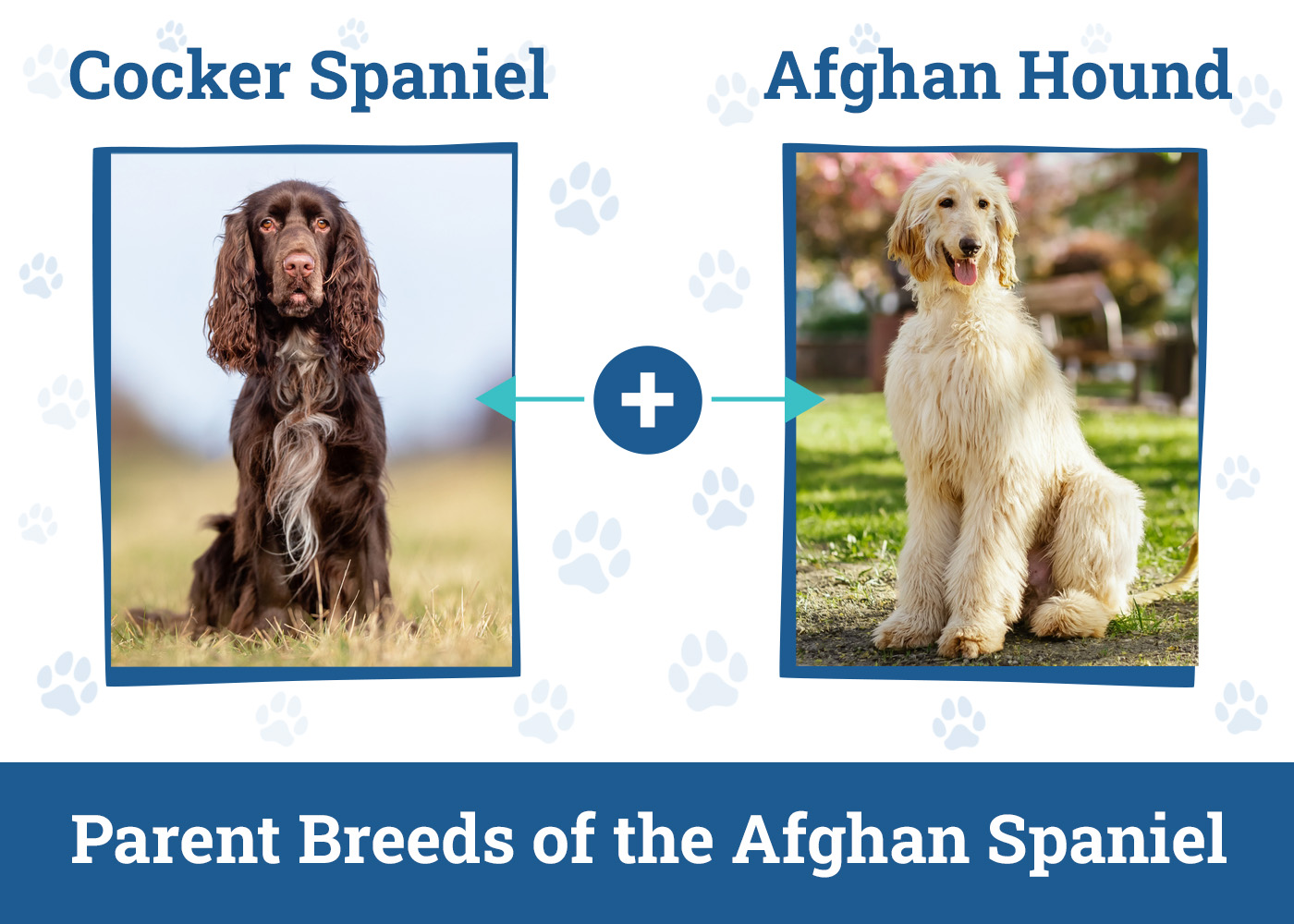

Temperament & Intelligence of the Afghan Spaniel
Afghan Spaniels descend from two dogs with opposing temperaments, so it can be a toss-up as to how yours will behave. The Afghan Hound and Cocker Spaniel are intelligent dogs, but how they apply that intelligence can make training relatively easy or challenging, depending on who your Afghan Spaniel takes after.
If your dog is more Afghan than Spaniel, you can expect an independent streak and a dog that chooses to obey when it meets their goals. By contrast, the Cocker Spaniel is eager to please and easy to train when you stay positive and consistent. The Cocker will also supply a more outgoing personality to offset the Afghan Hound’s wariness of others outside their close family.
Afghan Spaniels are also sensitive. No matter how easy they are to manage, you should take a patient, loving, and upbeat approach to training. Fortunately, both breeds bring an easy-going, non-aggressive temperament, a trait you can expect in your Afghan Spaniel.
Are These Dogs Good for Families? 👪
Afghan Spaniels usually inherit the Cocker Spaniel’s friendly, merry, and affectionate personality, making them a solid fit for many families. They’re playful and enjoy getting attention from others. As that can lead them to separation anxiety in some cases, it may even be better for them to have several people in the house to keep them company.
Does This Breed Get Along With Other Pets? 🐶 😽
Whether they take after the Afghan Hound or their Cocker parent, Afghan Spaniels are generally good with other pets. They may sport a prey drive, particularly from the Afghan side, that requires management outside.
In the house, other dogs and cats are generally well-accepted members of the group. Another dog can be a welcome addition to the group to give your Afghan Spaniel a play buddy, but you must be careful about proper introductions and reducing any chance for jealousy or resource-guarding.

Things to Know When Owning an Afghan Spaniel:
Food & Diet Requirements 🦴
Afghan Spaniels don’t have any unique dietary requirements but should enjoy a high-quality commercial diet with animal proteins as the first ingredients. Depending on their size, adults will eat roughly 2–3 cups of food daily.
Food is an excellent training motivator, but you must ensure treats only constitute 10% of your dog’s diet. You may also consider feeding smaller portions in several meals throughout the day, as deep-chested dogs like these are more prone to bloat.
Exercise 🐕
Due to their high-energy personality, exercise is a vital part of an Afghan Hound’s day. Adequate enrichment and workouts will keep your dog docile and content, preventing unwanted bored, mischievous, and stressed behaviors from under-stimulation or lack of attention.
A couple of walks and off-leash play in a fenced-in yard for at least 1–1.5 hours daily is usually sufficient. Brain games and assorted enrichment devices are crucial inside to keep your dog from becoming restless. Scent work is excellent for physical and mental exhaustion. You can let your dog sniff around on walks or engage them at home with snuffle mats, puzzle feeders, and hidden treats.
Training 🎾
As straightforward as training can be with the Afghan Spaniel, it’s also vital in reducing some of the less desirable at-home and social tendencies they might take from their parent breeds.
The Afghan Hound can be aloof and self-serving, making it crucial to make obedience part of the routine the second your Cocker Spaniel mix enters your home. Both parents bore quickly, which may lead to destructive habits if you don’t offer enough enrichment. Alongside the Afghan Spaniel’s susceptibility to separation anxiety and housebreaking challenges, this is often manageable with crate training.
Other struggles can include loose-leash walking due to the Afghan Spaniel’s heightened prey drive and varying levels of stubbornness from either breed (especially the Afghan side). They require firm guidance to keep them from doing things their way. At the same time, they’re sensitive to harsh punishment, so you must be as gentle as you are consistent.
Grooming ✂️
The Afghan Spaniel’s dependably long, thick hair requires significant attention and grooming effort. They need brushing at least three times weekly with a comb and slicker brush to prevent tangles and mats, while baths with a quality shampoo and conditioner may need to occur as often as every 2–4 weeks.
An occasional trim and grooming session with a professional every 2–3 months can make the coat more manageable. Since this mix won’t be a show dog, you can confidently give them a shorter cut to make weekly grooming easier.
Otherwise, standard care like trimming their nails every few weeks and brushing their teeth daily will keep your dog healthy and fit. Pay close attention to the floppy ears since they typically need weekly checks and cleaning to prevent infections.
Health and Conditions 🏥
As a mixed breed, Afghan Spaniels may be less susceptible to recessive genetic disorders unique to their Cocker Spaniel and Afghan Hound parents. Still, their deep chest can predispose them to bloat. They may also inherit eye and orthopedic issues shared between the parent breeds, including cherry eye, progressive retinal atrophy, and hip dysplasia.
Screening for these health issues before adopting isn’t easy, and it’s hard to be confident your dog won’t have any inherited issues. The Afghan Spaniel is a mixed breed that likely didn’t appear with significant dedication to sound breeding practices. As you budget for your new dog, shop for affordable pet insurance to ensure you can handle any health issue or injury.
- Ear infections
- Skin allergies
- Dilated cardiomyopathy
- Gastric dilatation volvulus (bloat)
- Hip or elbow dysplasia
- Patellar luxation
- Intervertebral disc disease
- Eye disorders (e.g., PRA, cherry eye, cataracts, entropion)
- Hypothyroidism

Male vs Female
Male and female Afghan Spaniels don’t differ much, and given the diverse possibilities for their body shape and personalities, ascribing particular traits to either gender is difficult.
Many find males are more playful and affectionate, while females seem more independent, serious, and laid back. Some owners also find females easier to train and quicker to mature than their male counterparts, and when desexed, they often live longer.

3 Little-Known Facts About the Afghan Spaniel
1. Afghan Spaniels Can Be Surprisingly Aggressive
Some dogs tend to fly off the handle, but Cocker Spaniels have a unique knack for aggression they may pass on to their Afghan Spaniel children. English Cocker Spaniels, in particular, have a higher prevalence of angry growling or biting when agitated and are known for an associated “rage syndrome,” a condition involving sudden, unprovoked aggressive outbursts.
Males are more likely to exhibit aggression than females, and English Cocker Spaniels with solid-colored coats show a significantly higher occurrence of it than bi or tri-colored varieties. One study found it was most common in gold-colored dogs, with roughly 12% displaying aggressive behavior.
In a 2024 study of English Cocker Spaniels in Poland, dogs were often more aggressive toward people and animals if they didn’t have a pedigree or came from a shelter. As this is often the case with mixed breeds like Afghan Spaniels, aggression may be a more distinct possibility.
2. Afghan Spaniels Aren’t Always the Smartest Dogs
In 1994, canine psychologist Stanley Coren published his ranking of dog breeds according to their smarts in The Intelligence of Dogs. Compiling survey results from 199 dog training professionals, Coren examined a dog’s adaptive, instinctive, and working intelligence to build his definitive roundup, primarily looking at how they responded to commands.
Unsurprisingly, the Border Collie and other skilled herding and working dogs earn the highest ranks on Coren’s list. But which breed comes in dead last? Our Afghan Hound, due to their overwhelming stubbornness and independence. It doesn’t mean they aren’t generally intelligent, but Afghan Hounds and the similarly cat-like Basenji tend to decide to obey only when it suits them.
For their part, the Cocker Spaniel is relatively high on Coren’s ranking, sitting within the “Excellent” tier of dogs that obey at least 85% of the time. Your dog may subsequently be much more biddable, but there’s always a chance they’ll inherit their Afghan Hound parent’s “what’s in it for me?” approach to obedience.
3. The Afghan Spaniel Has Pioneering Parents
The Afghan Spaniel may not have the global renown many other dog breeds enjoy, but their parents will forever hold a place in the history books for their collection of firsts. The Afghan Hound, for instance, has the distinction of being the first cloned dog.
In 2005, Snuppy became the world’s first canine derived from the adult cells of a single dog. He later earned recognition as one of Time magazine’s most amazing inventions that year. The Cocker Spaniel similarly made recent history by becoming one of the first dogs to prove an ability to detect cancer.
In a 2004 study, scientists showed dogs could detect bladder cancer from a patient’s urine, with two Cocker Spaniels having the best accuracy rate of 56%.

Final Thoughts
Will your Afghan Spaniel have the Cocker’s merry, loving personality or the Afghan’s quiet independence? There are countless possibilities between these two seemingly mismatched personalities, but whichever way they lean, you’ll enjoy an easy-going and pleasant personality suitable for all kinds of living situations.
Provide a stable routine and firm yet positive guidance, and your Afghan Spaniel will make every effort to maintain a happy, loving, and cooperative relationship.
See also:
- Afghan Collie (Afghan Hound & Border Collie Mix): Info, Pictures, Care & More
- Afghan Retriever: Breed Info, Pictures, Care Guide & More
